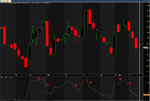fatowl
Junior member
- Messages
- 33
- Likes
- 0
Hey guys and gals. I just had an interesting idea that sounds like something most mechanical system designers/traders have not done.
Let's say you identify a certain price pattern or indicator pattern. Name it "Price Pattern A". Plenty of backtesters would try to get a histogram of closing prices for 1, 2, 3,... days after Price Pattern A. However, wouldn't it be interesting to get a histogram of closing prices for 1, 2, 3,... days before Price Pattern A?
For instance, what if we found that any one of these were true:
1. 90% of the time, Price Pattern B preceded Price Pattern A within 10 days.
2. 5% of the time, Price Pattern C preceded Price Pattern A within 10 days.
3. Price Pattern D never preceded Price Pattern A within 10 days.
This could give you somewhat of an edge. Say for instance, during your trading, you noticed that either Price Pattern C or Price Pattern D occured. You could be extremely confident that Price Pattern A will not occur in the near future.
I am perplexed at Price Pattern B though. Let's say that Price Pattern B occured. Then, you could lookout for Price Pattern A, but you cannot say there is a 90% chance of it occurring. The reason is causality. The presence of A implies that B occured in the past 10 days with a 30% chance. However, does B cause A? You would have to run a separate backtest on that. It is possible that B causes A 1% of the time or 100% of the time. Think about it this way: every car crash involves a car (this is 100% certain), but only a small percentage of cars get into a crash. Here, the car crash represents Price Pattern A, and the presence of a car represents Price Pattern B.
I'm spinning myself in loops here. Just wanted to see if anyone has seen some research or tried this themselves. I feel like there might be an academic paper on it in quantitative finance.
Let's say you identify a certain price pattern or indicator pattern. Name it "Price Pattern A". Plenty of backtesters would try to get a histogram of closing prices for 1, 2, 3,... days after Price Pattern A. However, wouldn't it be interesting to get a histogram of closing prices for 1, 2, 3,... days before Price Pattern A?
For instance, what if we found that any one of these were true:
1. 90% of the time, Price Pattern B preceded Price Pattern A within 10 days.
2. 5% of the time, Price Pattern C preceded Price Pattern A within 10 days.
3. Price Pattern D never preceded Price Pattern A within 10 days.
This could give you somewhat of an edge. Say for instance, during your trading, you noticed that either Price Pattern C or Price Pattern D occured. You could be extremely confident that Price Pattern A will not occur in the near future.
I am perplexed at Price Pattern B though. Let's say that Price Pattern B occured. Then, you could lookout for Price Pattern A, but you cannot say there is a 90% chance of it occurring. The reason is causality. The presence of A implies that B occured in the past 10 days with a 30% chance. However, does B cause A? You would have to run a separate backtest on that. It is possible that B causes A 1% of the time or 100% of the time. Think about it this way: every car crash involves a car (this is 100% certain), but only a small percentage of cars get into a crash. Here, the car crash represents Price Pattern A, and the presence of a car represents Price Pattern B.
I'm spinning myself in loops here. Just wanted to see if anyone has seen some research or tried this themselves. I feel like there might be an academic paper on it in quantitative finance.

